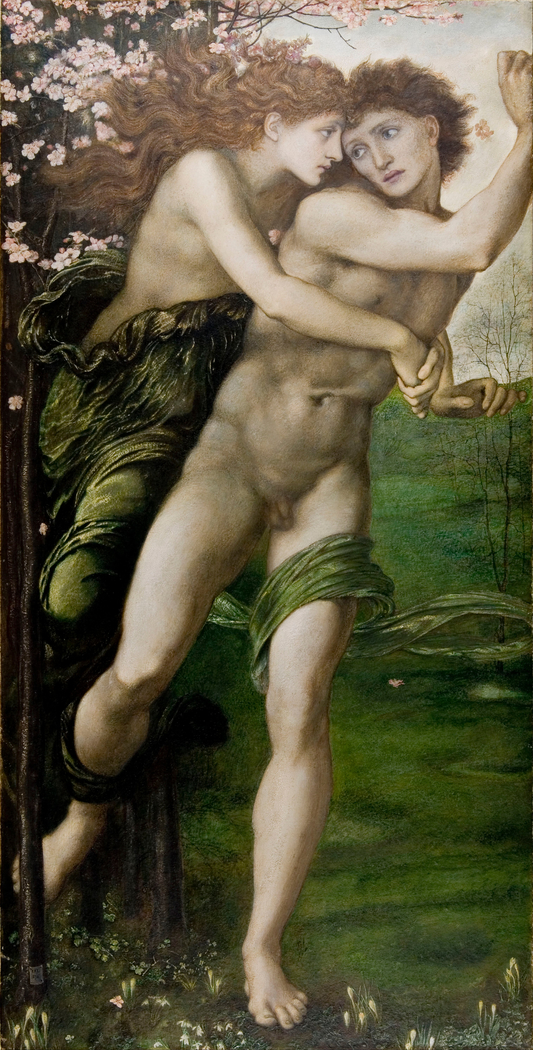Created by Maya Fitzgerald on Sat, 10/24/2020 - 09:43
Description:
The style of the Pre-Raphaelite Circle primarily centered around aestheticism, a style of art deviating from modern conventional attitudes (Dennis 2).Its doctrine revolves around one’s private utopia, focusing on perceptions of perfection and artistic ideals (Dennis 2).Many aesthetic pieces challenged cultural and societal norms, particularly related to sensuality and morality. The aesthetic characteristics of art from the Pre-Raphaelite Circle encompassed deviations from the status quo, representation of middle-class authority, and sensuality of men and women (Dennis 4).Additionally, the Pre-Raphaelites also incited cultural change through their art, particularly in the portrayal of women, who were depicted with voluptuous figures, long, bushy hair, and medieval dress (Dennis 4).The definition of Pre-Raphaelite aestheticism arose through artistic contributions from Dante Gabriel Rossetti, Edward Burne-Jones, and John William Waterhouse.
Despite previously associating with the Pre-Raphaelite Brotherhood, Dante Gabriel Rossetti abandoned the group’s “true to nature” focus in favor of incorporating sensual, symbolic, and experimental aspects of aestheticism (West, 2). Upon joining the Pre-Raphaelite Circle after 1860, Rossetti’s style shifted to rich, sensual portraits of women (West 2) He changed his conceptualization of the female figure, depicting woman as voluptuous, resulting in controversy about the morality of his work (Prettejohn 5).Furthermore, Rossetti focused on the upper half of their figures to enhance the erotic and intimate nature of his portraits by closing the amount of perceived space between the viewer and the subject of the painting (Prettejohn 5). This style was regarded as improper due to its deviation from the standard spatial organization of figures in the painting, removing the traditional divide between the real and fictional worlds (Prettejohn 5).

In addition to challenging Victorian morality, Rossetti challenged Victorian perceptions of beauty through his incorporation of imagined perception of senses into his work. This allowed him to defy the limitations of vision as an indication of beauty. For example, in his painting “The Blue Bower,” Rossetti emphasized the detail of the lyre and hand positioning to invoke the imagination of sound in his audient. Furthermore, he implied a floral scent to the woman through his use of flowers on the wallpaper and in her hair. Through these methods, Rossetti portrayed women through rich, earthy sensuality (West 4)
.
Edward Burne-Jones also embraced aestheticism to express his ideals of romance and perfection, beauty, and morality. Burne-Jones depicted women as a method of portraying the idea of love as defined by the cultural norms. Through his work, he combines the ideas of the natural and aesthetic realms to explore beauty (Cheney xxv). In his solo narrative paintings, Burne-Jones explores the concept of love for innocent and seductive women(Cheney xxv). For these, he uses an aesthetic suspended imagery style to portray the contemplation of beauty. He also utilizes aspects of space intime in his decorative cycles paintings, which were visual narrations of stories, often mythological ones (Cheney xxvi).

Furthermore, Burne-Jones employs androgenous figures to explore male beauty and love. Burne-Jones established a hallmark look for males in his work, giving them an asexual look consisting of sharp facial features, small torsos, and pale, smooth skin. This androgyny blurred the lines defining love between men, as it appeared to promote male homosexuality while also aligning with the Greek ideal of platonic love among men (West 14).
Similar to the others, John William Waterhouse employs aestheticism to add a mythical component to his work. Waterhouses’s subjects stem from the past, rather than mirroring those in the modern world. Furthermore, he forwent painting landscapes and modern portraits in favor of incorporating Greek mythology, often incorporating human-like creatures into his work, such as mermaids, sirens, and nymphs (Silver 265). Furthermore, Waterhouse took inspiration from mythical literature such as that of Alfred Lord Tennyson, which provided the inspiration behind pieces such as “The Lady of Shallot” and “The Palace of Art,” (Silver 265).Due to the mythological nature of his work, religious symbols were rarely used, with the exception of his pieces St. Eulalia, St. Cecilia, and Mirarmne (Silver 265).
Additionally, Waterhouse’s work focused on the depiction of women as romantics and femme fatales. He portrayed this by highlighting female sensuality in his work. Many of his paintings depicted young, slender girls with pale skin and dark hair. Waterhouse created an erotic nature in his pieces by painting his figures in translucent fabric with one breast revealed (Silver 266). Outside of sensuality, Waterhouse also created works that represented women in non-sexual contexts as well. When focusing on medieval, Renaissance, and later non-narrative works, he drew attention away from their sexuality by fully clothing them in order to place a greater emphasis on their complexity (Silver 266).
Dante Gabriel Rossetti, Edward Burne-Jones, and John William Waterhouse contributed to the definition of Pre-Raphaelite aestheticism through their incorporation of fantasy and symbolism into their work. While each artist had his own focus, their creations all challenged the cultural norms of the time period.
Resources
Cheney, Lina. Edward Burne-Jones’ Mythical Paintings. New York, Peter Lang, 2014.
Denisoff, Dennis. Decadence and aestheticism. Cambridge, Cambridge University Press, 2007.
Lane, Allen. The Pre-Raphaelites. London, Pearson, 1984.
Prettejohn, Elizabeth. The Painting of Dante Gabriel Rossetti. Cambridge, Cambridge University Press, 2012.
Silver, Carole. “Waterhouse Revisited.” Victorian Literature and Culture. 39, 1, 2011, 263-269.
West, Shearer. The visual arts. Cambridge, Cambridge University Press, 2007.
Images
Burne-Jones, Edward. “Phyllis.” 1870. Gouache on Paper. Useum. https://az334034.vo.msecnd.net/images-1/phyllis-and-demophoon-edward-burne-jones-1870-1-efdc2922.jpg Accessed 23 Oct 2020
Rossetti, Dante. “The Blue Bower.” 1865. Oil on Canvas.Wikipedia. https://upload.wikimedia.org/wikipedia/commons/c/c5/Dante_Gabriel_Rossetti_-_The_Blue_Bower.jpg Accessed 23 Oct 2020
Waterhouse, John. “Circe Offering the Cup to Ulysses.” 1891. Oil on Canvas. JWWaterhouse. https://lh3.googleusercontent.com/proxy/Nk29WPjcNiEcw49F7wc9ItcObIMAULiju1M39oCYbHX3OgmTrWBdK380U54YU00Mg_IcD_Uz70chVReUBfJJl0Go_P8YOBt9jkHniDMYcY1AENNrCaqNeY8i1Sd51-b2aTRDijRO70fc64PmWKTKwt4zEcJN Accessed 23 Oct 2020


